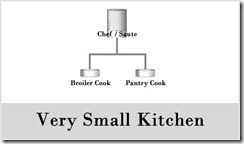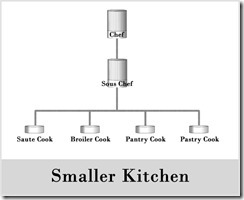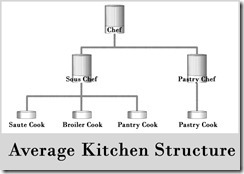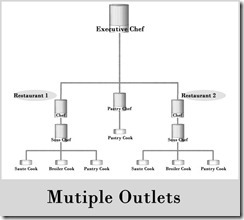 At one point or another I am sure you have wondered to yourself, who is in charge of what? or why does the food always go to pot on Tuesdays? I mean in a traditional work environment it is pretty straight forward, but in kitchens, throwing around some crazy new words, and it can get a bit confusing. To that end I thought I would touch on who is responsible for what in a few kitchens, structures and what all these titles mean. The word chef and the chef coat used to be reserved for those in charge, it was something to be earned. Now, it is pretty much a uniform, and it can be even harder to tell.
At one point or another I am sure you have wondered to yourself, who is in charge of what? or why does the food always go to pot on Tuesdays? I mean in a traditional work environment it is pretty straight forward, but in kitchens, throwing around some crazy new words, and it can get a bit confusing. To that end I thought I would touch on who is responsible for what in a few kitchens, structures and what all these titles mean. The word chef and the chef coat used to be reserved for those in charge, it was something to be earned. Now, it is pretty much a uniform, and it can be even harder to tell.
Some Common Roles and Terms
Executive Chef is usually a chef who is in charge of multiple chefs, but it can also be a sole chef in an establishment. In a traditional sense this role was in a place that had multiple outlets for food, like a hotel, with a chef in each outlet.
A Corporate Chef or Corporate Executive Chef is someone who is responsible for a lot of outlets and usually multiple locations. The person in this role is responsible for food on a large scale, and this is typically the pinnacle position.
Multiple outlets refers to one structure that has many points of selling food. A hotel with three restaurants, a cafeteria, a coffee shop, and room service would be a great example.
Multiple Locations would refer to a restaurant company that might have three locations in separate geographic areas where you can’t share resources or people easily.
Executive Sous Chef is basically the assistant to an Executive Chef and is usually more involved in production and scheduling, which frees up the Exec to focus on creativity and costs.
The Chef is the person who is in charge of a given kitchen. In his kitchen he reigns supreme. The title is also what we will call the person when we need something. “Hey Chef, I need a Risotto on the fly.”
Sous Chef is the assistant to the Chef. Sous actually means “second” in French. A chef may actually have a few Sous Chefs under him as they will usually take his place on his days off.
Cooks are the base of the whole operation. These are the guys who make it happen. In larger kitchens the Chef or Sous might not even cook on a day to day basis. The role they will usually take on is what we call an expediter.
The Expediter is the role is to make sure the food comes out together, up to snuff and on time.
The Kitchen Manager is something else entirely, and while they may be responsible for the operations of a kitchen, rarely is someone with this title playing a creative role.
Organizations
 The Very small kitchen is pretty common, more so in Europe where this is a typical set up. The Chef will work a station, usually the most crucial, so the owner can save some money on the other stations instead of paying for skilled help on the hardest station. The problem here is that there is usually no one to cover on the days off, so unless the restaurant is closed for a set day in the week, you could be in for a sub-par experience on the chef’s day off.
The Very small kitchen is pretty common, more so in Europe where this is a typical set up. The Chef will work a station, usually the most crucial, so the owner can save some money on the other stations instead of paying for skilled help on the hardest station. The problem here is that there is usually no one to cover on the days off, so unless the restaurant is closed for a set day in the week, you could be in for a sub-par experience on the chef’s day off.
More typical is the Smaller Kitchen here in the states. This one there is actually a person designated as Sous Chef. Either the Sous or Chef will take turns working the stations as the cooks have off, or there will be enough to staff. Usually the Chefs will expedite on the busier days like Fridays and Saturdays, opting to ensure quality and consistency of the shifts.
An average size kitchen will be your busier restaurants that actually might have a pastry chef. Typically the pastry chefs report directly to the Chef of the restaurant, but not the sous. When it comes to working positions it is possible that a chef in a configuration such as this is more focused on operations and may not even cook much, outside of creating menu items. It is a pretty flexible structure, and may even require another Sous Chef to operate if the restaurant is busy enough to support the extra expense. I have even seen cases where there are multiple Pastry Chefs to ensure enough food was getting prepared.
Now the size is getting larger, and there may be an Executive Sous Chef in this or chart, but you can see that the restaurants will act like “departments” under the Exec. Also the Pastry chef in these operations will tend to have a central location and service all of the outlets from there. In a Hotel this is very typical. When it comes to a multiple location scenario, then there would probably be a Pastry at each location like the Average structure above. It is a rarity that a chef will be able to cook in the actual restaurant itself when there is so much to do.
To expand or not?
My favorite restaurant most likely failed as a result of trying to stretch a winning formula too far. A very renowned chef opened a charming restaurant, and you would meet her on occasion even as she wandered the dining room. Then the idea to open another location surfaced and now you are taking a chef and owner, already one of the hardest jobs if you ask me, and doubling the work load, AND overseeing construction of the new building. It proved too much, the original unit suffered from her not being there, the menu wasn’t changed as frequently, and before you know it they both closed. A sad tale with an unhappy ending, and yet again, a great formula ruined.
Now you know
There you have it, you now know what an Executive Sous Chef actually does! It is a convoluted structure, and like everything, it is just titles, and there are people who love the titles more than the job, unfortunately. But knowing a little but about the structure can help you choose which restaurants you will frequent, when the chef works is almost as important as which restaurant to choose on many occasions








